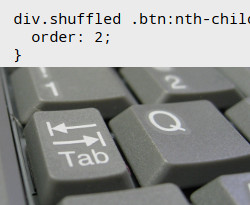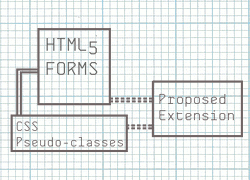 In the past, I have been an accessibility lead on a project that had videos with scenes that could potentially cause seizures. When I approached the video creators about these issues, they said they didn’t know how to fix these issues. When I created my own music video that had problematic sequences in them, however, I found that these issues are not really that hard to fix. This article shows that it’s not too hard and you can fix these problems in no time.
In the past, I have been an accessibility lead on a project that had videos with scenes that could potentially cause seizures. When I approached the video creators about these issues, they said they didn’t know how to fix these issues. When I created my own music video that had problematic sequences in them, however, I found that these issues are not really that hard to fix. This article shows that it’s not too hard and you can fix these problems in no time.
Entries Tagged as 'CSS3'
How to Fix Seizure Inducing Sequences In Videos.
Tags: accessibility · animation · Color · Uncategorized · video
Using PEAT To Create Seizureless Web Animations
 Photosensitive Epilepsy should be a concern to anyone creating any type of animated media. As a matter of fact, in order to pass WCAG Level A, a web page cannot “contain anything that flashes more than three times in any one second period, or the flash is below the general flash and red flash thresholds”. Testing this requirement may seem a little daunting at first, but luckily there is a free tool called PEAT that web developers can use to test if their animations and videos can cause an epileptic attack. This blog post talks about how to use PEAT, what it’s limitations are, and how to work around them.
Photosensitive Epilepsy should be a concern to anyone creating any type of animated media. As a matter of fact, in order to pass WCAG Level A, a web page cannot “contain anything that flashes more than three times in any one second period, or the flash is below the general flash and red flash thresholds”. Testing this requirement may seem a little daunting at first, but luckily there is a free tool called PEAT that web developers can use to test if their animations and videos can cause an epileptic attack. This blog post talks about how to use PEAT, what it’s limitations are, and how to work around them.
Tags: accessibility · animation · Color · Cygwin · Uncategorized
Flex Layout Fail: Fixing Firefox’s Keyboard Accessibility Bug With The CSS order Property
 Firefox, unlike every other browser on the planet, changes the way that keyboard navigation works in designs that use the CSS
Firefox, unlike every other browser on the planet, changes the way that keyboard navigation works in designs that use the CSS order property. Since a lot of developers use flexbox, this can create a lot of cross-browser accessibility issues. This article shows a fix for this problem using a small amount of Javascript.
Tags: accessibility · CSS · flex-layout · order · Uncategorized
Augment Photos With CSS3 matrix3d() Transforms
 It’s possible to super-impose dynamic HTML content on top of a photos using 3D transforms to give the appearance that it is part of the picture. However, using a combination of
It’s possible to super-impose dynamic HTML content on top of a photos using 3D transforms to give the appearance that it is part of the picture. However, using a combination of translate3d(), scale3d() and rotate3d() functions to do this is difficult. This article discusses how to use the matrix3d() CSS transform with the Matrix Construction Set to get pixel-perfect 3D transforms easily and without any knowledge of matrix arithmetic. It also discusses the differences between matrix() and matrix3d(), as well as what fallbacks to use for browsers that don’t support transforms.
Tags: 3d · CSS · CSS3 · matrix · matrix3d · transform · transform3d · transform3d · Uncategorized
Fixing Cross-Browser Issues With CSS3 Viewport Units in IE9+ and Safari for iOS
 With viewport units, you can describe width, height, font-size and other CSS styles as percentages of the viewport width and height. There are, however, a few nasty gotchas when it comes to using them in iOS Safari and IE9 and 10. They also don’t always play nice in CSS3
With viewport units, you can describe width, height, font-size and other CSS styles as percentages of the viewport width and height. There are, however, a few nasty gotchas when it comes to using them in iOS Safari and IE9 and 10. They also don’t always play nice in CSS3 calc() statements and don’t work at all in IE Visual Filters. Using them in iframes can also be problematic. This post talks about how to work around these issues easily using a JavaScript buggyfill (not polyfill). I have used viewport units in production sites today, and now you can too, on any phone or device used in the wild today.
Tags: CSS · CSS3 · IE Visual Filters · math · viewport units
Animating Circular Paths Using CSS3 Animations.
 For the longest time I assumed that one couldn’t use CSS Transitions or animations to move DOM objects in anything but a straight path. Sure, a developer could use multiple keyframes to create a list of straight paths to simulate a curve, but I didn’t think one could just define a curve with just two keyframes. I was wrong. If you are coding for a modern web browser, then this is very doable!. This article will show you how it’s done in modern browsers, the math involved, and what to do with older versions of IE that don’t support CSS3 Animations.
For the longest time I assumed that one couldn’t use CSS Transitions or animations to move DOM objects in anything but a straight path. Sure, a developer could use multiple keyframes to create a list of straight paths to simulate a curve, but I didn’t think one could just define a curve with just two keyframes. I was wrong. If you are coding for a modern web browser, then this is very doable!. This article will show you how it’s done in modern browsers, the math involved, and what to do with older versions of IE that don’t support CSS3 Animations.
Tags: animation · animation · CSS · CSS3 · JavaScript · math · transform · transition
Cross-Browser Animated Image Masking (Even in IE) Using polyClip.js
 I first created polyClip.js so I could combine the lossy compression algorithm of JPEGs with the ability to have a transparent area that PNGs allow. The result works well in all browsers, but can polyClip.js be fast enough to change the clipping area on-the-fly and even animate it at reasonably fast speeds with CSS3-style transformations on the clipping areas. The answer is a resounding yes and it is really fast even in older IE as well. This article will discuss in doing this with polyClip and a related library, Silk.js to do battery friendly and CPU efficient HTML5 animations.
I first created polyClip.js so I could combine the lossy compression algorithm of JPEGs with the ability to have a transparent area that PNGs allow. The result works well in all browsers, but can polyClip.js be fast enough to change the clipping area on-the-fly and even animate it at reasonably fast speeds with CSS3-style transformations on the clipping areas. The answer is a resounding yes and it is really fast even in older IE as well. This article will discuss in doing this with polyClip and a related library, Silk.js to do battery friendly and CPU efficient HTML5 animations.
Tags: animation · canvas · HTML5 · Images · JavaScript · jQuery · requestAnimationFrame · transform
CSS3 Pseudo-Classes and HTML5 Forms: Their Limitations and a Possible Solution
 I have been playing around with HTML5 Forms for a while now, and one of my favorite parts of the HTML5 Forms spec is the use of CSS3 pseudo-classes to show the validation state of the form fields to the user. I believe these validation hints make a better user experience and makes the process of filling out the form less frustrating. However, I think there are some shortcomings in the existing psuedo-classes that produce these validation hints. I hope that this article will start a discussion for a possible solution that could be easily added to the CSS3 UI specification.
I have been playing around with HTML5 Forms for a while now, and one of my favorite parts of the HTML5 Forms spec is the use of CSS3 pseudo-classes to show the validation state of the form fields to the user. I believe these validation hints make a better user experience and makes the process of filling out the form less frustrating. However, I think there are some shortcomings in the existing psuedo-classes that produce these validation hints. I hope that this article will start a discussion for a possible solution that could be easily added to the CSS3 UI specification.
Tags: CSS3 · forms · HTML5 · psuedo-classes · standard proposal · Uncategorized
Cross Browser Styling of HTML5 Forms — Even In Older Browsers.
 I have updated my html5Widgets package (now called html5Forms.js) so developers can create great looking, easy-to-use forms that can validate each field as a user types. It also has updated validation widgets so older browsers can display error messages like native HTML5 Form implementations do, and even allows developers to style error message bubbles in all browsers even in browsers like Firefox that don’t allow it natively.
I have updated my html5Widgets package (now called html5Forms.js) so developers can create great looking, easy-to-use forms that can validate each field as a user types. It also has updated validation widgets so older browsers can display error messages like native HTML5 Form implementations do, and even allows developers to style error message bubbles in all browsers even in browsers like Firefox that don’t allow it natively.
Tags: CSS3 · Forms · HTML5 · Uncategorized
Cross Browser HTML5 Progress Bars In Depth
 As a web application developer, progress bars are great when you want to show the user that some action is happening, especially when it can take a long time. Creating them is easy with the HTML5
As a web application developer, progress bars are great when you want to show the user that some action is happening, especially when it can take a long time. Creating them is easy with the HTML5 <progress> tag. This article will discuss how this tag is rendered by default in all operating systems and browsers and how to style the progress tag with CSS, even in browsers that don’t officially support the it. It will also show some interesting examples using advanced CSS3 techniques.
Tags: CSS3 · Forms · gradients · HTML · HTML5 · Polyfills · progress
 @zoltandulac
@zoltandulac
 @zoltandulac
@zoltandulac Zoltan Hawryluk
Zoltan Hawryluk